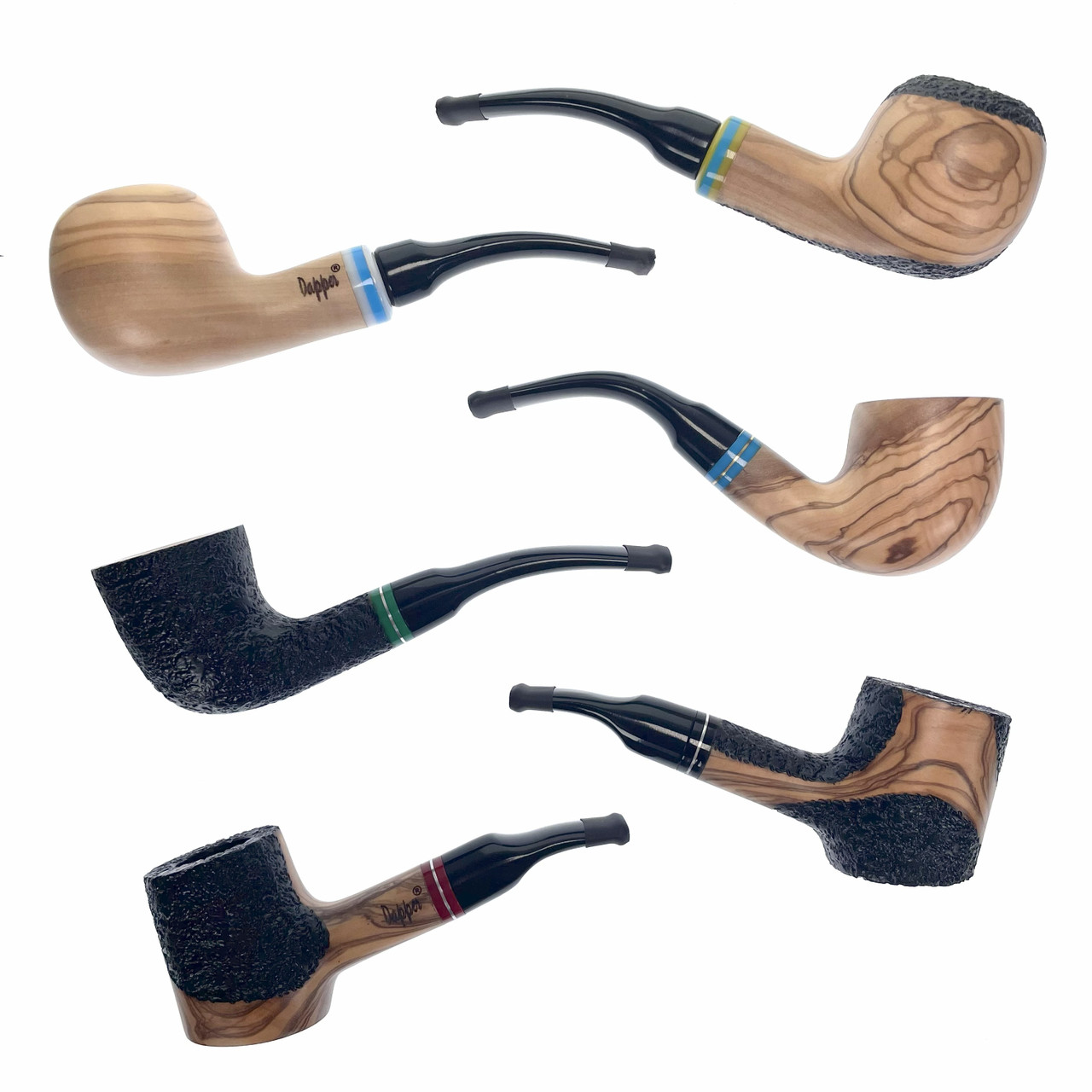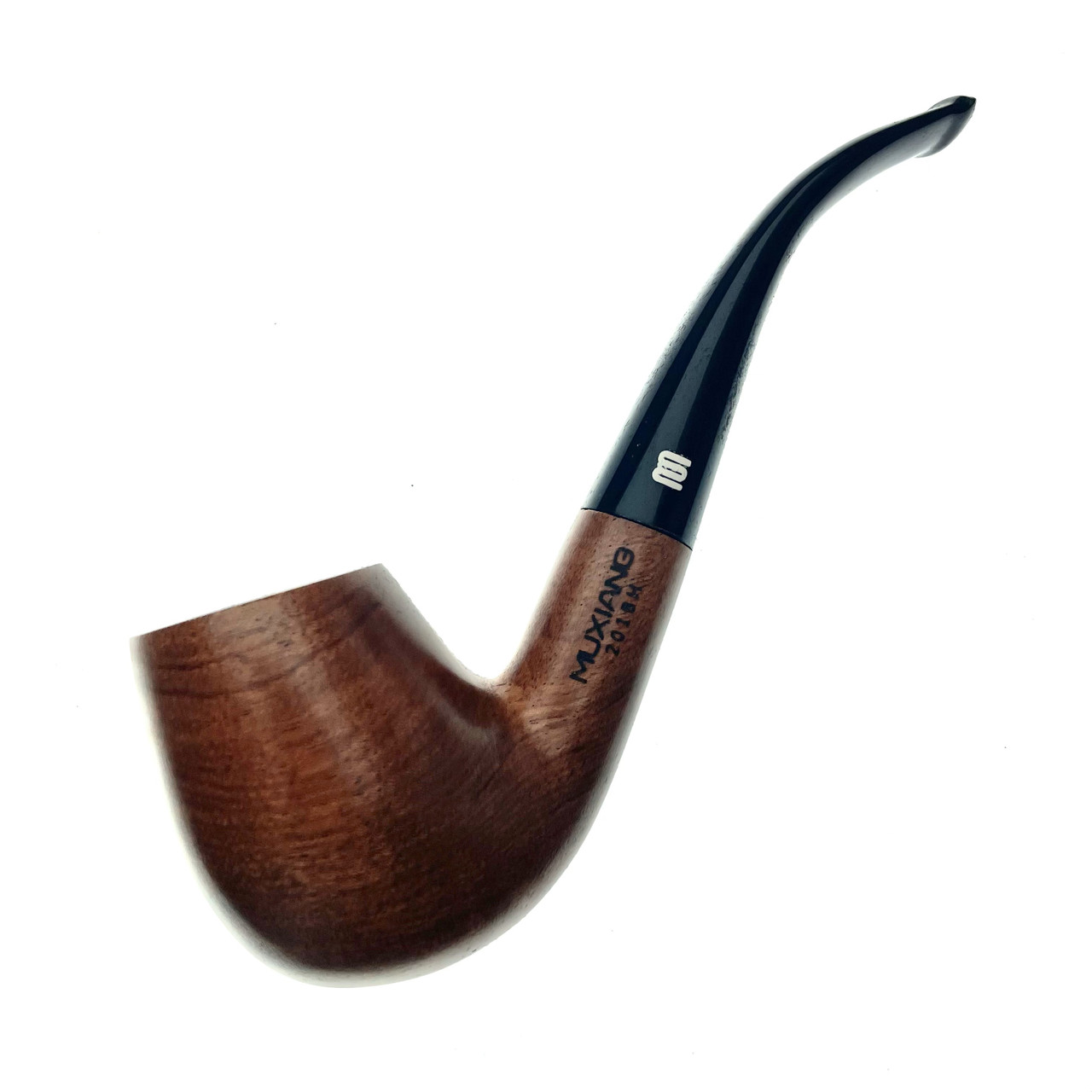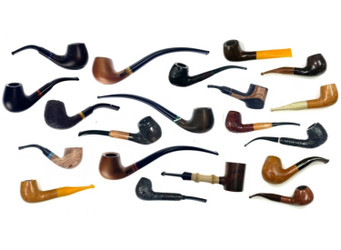High-end personalized wooden pipes come in many shapes and forms. In this article, Paykoc Pipes' tobacco pipe sellers explore everything you need to know about wooden pipes. Read on for an overview of briar pipe mouthpiece types, different briar pipe finishes, and tips to help you maximize your briar pipe smoking experience.
Wooden Pipe Materials
Choosing the right wood can change how a pipe feels in hand, how it handles heat, and even the subtle character of the smoke. Below is a quick, buyer-friendly guide to four popular wooden pipe materials – briar, olive wood, cherry wood, and rosewood – so you can match material traits to your preferences.

Briar Pipes
Briar (from the root burl of Erica arborea) is the benchmark for wooden pipes. Its tight grain, natural heat resistance, and ability to breathe make it a durable, dependable choice for everyday smoking and long-term use.
PROS
- Excellent heat resistance and burnout protection
- Lightweight yet durable; seasons well over time
- Generally neutral flavor that lets tobacco shine
CONS
- Often pricier than other woods of similar size
- High-grade straight grain commands a premium
- Still requires rest and proper cadence to prevent overheating

Olive Wood Pipes
Olive wood offers striking, high-contrast grain with a dense feel in hand. When properly cured, it provides a clean smoke with a faintly woody or “nutty” character that some enthusiasts appreciate.
PROS
- Beautiful, dramatic grain patterns – great display pieces
- Dense structure with solid durability when cared for
- Can impart a subtle, pleasant character during break-in
CONS
- May run warmer than briar if puffed aggressively
- Initial curing and break-in can take longer
- Overheating or rapid cool-downs can encourage checking/cracks

Cherry Wood Pipes
Cherry wood pipes are typically lighter and can feel “lively” in the hand. Many smokers describe a gentle sweetness during early bowls, which mellows as a protective carbon layer builds.
PROS
- Lightweight and comfortable for clenching
- Approachable price points; good for first wooden pipes
- May offer a softly sweet character during break-in
CONS
- Less heat-tolerant than briar; benefits from slower cadence
- More prone to burnout if overheated or poorly rested
- Flavor can vary based on curing and finish quality

Rosewood Pipes
“Rosewood” refers to several richly colored, oily hardwoods known for deep reds and browns. Used thoughtfully, it makes visually striking pipes; however, it typically prioritizes aesthetics over maximum heat management.
PROS
- Luxurious color and figure; highly decorative
- Dense feel with a smooth, glassy finish when polished
- Often good value for dramatic looks
CONS
- Can smoke warmer than briar; careful pacing recommended
- Natural oils may influence early flavor until fully seasoned
- Quality varies by species and curing – buy from reputable makers
There’s no single “best” wood – just the best fit for how you like to smoke and what you value most (heat handling, flavor neutrality, or eye-catching grain). Match your cadence and care routine to the material, and any of these woods can become a long-term favorite.
Popular Wood Pipe Finishes
Every tobacco pipe enthusiast has their own favorite finish. Some love the rough, gnarly feel achieved by sandblasting, while others want something smooth and lustrous. Many pipe smokers love contrasting grain coloration while others can’t abide a pipe without a rusticated surface. So which briar pipe finish is best? And does the type of finish you choose impact the smoking experience in any significant way?
The stunning variety of looks available for wooden pipes lead some to believe there are hundreds of techniques being used to achieve them. Actually, it’s the skill of the pipe finishers that makes it seems like each different look is the result of a different process. Here are a few of the most popular finishes for wooden pipes.
Contrasting Grain Finish
Contrasting grain finishes might look like they’re easy to achieve but you’d better believe they are not. Pipe finishers' collective dedication to their craft makes it appear that the two-tone grain is a natural effect, as if all the finisher did was sand things down a bit and apply a hard wax coating. In reality, the finish is the result of two separate stains applied with meticulous care that bring out the light and dark features of the briar. It’s like bumping up the contrast in a photo processing software application, except that learning how to draw out the innate contrast in briarwood is a skill that can take years to master.
Rusticated Finish
The process of adding a unique texture to briar pipes is called rustication. Briar pipes that may not easily lend themselves to a smooth finish are often chosen for rustication and that’s just fine for the legions of pipe enthusiasts worldwide who clamor for the look. Rustication itself is a single process of introducing texture, but there are as many ways to introduce that texture as there are pipe makers. Most rustication tools are proprietary; that is they are custom-made by the individual pipe maker. A single pipe maker may have dozens of different tools they use to achieve different surface effects. As a result, each pipe is a unique work of art as much as it is an instrument for enjoying fine tobacco.

Sandblasted Finish
Sandblasting is the process of firing sand, glass, or some other type of abrasive material at the briar under intense pressure to strip away the soft wood. What’s left behind are craggy ridges of hardwood that present a texture many find very appealing. Also, by creating all those gnarly ridges, peaks, and valleys the exterior surface of the pipe is actually increased. Increased surface means increased heat dissipation and somewhat cooler smoke. Sandblasted pipes are very popular and as a result, just about every manufacturer offers several variations on the theme.

Smooth Finish
Many pipe enthusiasts love the look and feel of a flawlessly smooth high-gloss finish. This type of finish has an air of easy sophistication about it that makes it the right choice whether you’re watching TV after dinner, pouring over proposals in the office, or taking the boat out for a leisurely Sunday sail. The finish is arrived at by sanding the briar with increasingly finer grades of sandpaper. Once a silky smooth surface is attained a hard wax is applied that fills in any minute scratches and creates that deep, rich, much sought-after glow. A similar effect may be achieved using a lacquer, but there are many pipe aficionados who believe the lacquer finish will cause the pipe to burn hot.
Will a Wood Pipe's Finish Affect the Way It Smokes?
In a word, yes. But that needs to be qualified just a tad because the only real difference between the way wooden pipes with different finishes smoke is manifested in the temperature of the bowl and these temperature variations are often so small as to be almost unnoticeable. But the fact remains that there is some measurable difference in the temperature between a smooth finish pipe and a rusticated or sandblasted pipe; with the sandblasted or rusticated pipe smoking generally a bit cooler. It’s a small difference, sure. So small that some people won’t notice, sure. But it’s there and you may want to consider this before deciding which pipe is right for you.
In the end, the answer to which finish is actually ‘best’ comes down to a matter of taste, as it does with many things. Some people will think the gnarled, coarse surface of the sandblasted pipe represents the pinnacle of the pipe maker’s art, while others will hold the same opinion about a smooth finish. At Paykoc Pipes, we carry a full range of wooden pipes that will satisfy every taste. If you’re looking for the perfect gift for that hard-to-buy-for person on your list - or high-end wholesale tobacco pipes to stock your novelty store - you can’t go wrong with Paykoc Pipes' stunning wooden pipe selection – including high-end briar pipes, olive wood pipes, and other popular options.
Wood Pipe Mouthpiece Materials
The mouthpieces on most wood pipes today are made of either vulcanite or acrylic. Here’s a quick look at each material.
Vulcanite Mouthpieces
Vulcanite is a type of rubber that has been vulcanized through the application of heat and sulfur. Vulcanite mouthpieces are renowned for their soft, comfortable grip and over time will conform to the shape of the smoker’s teeth. Vulcanite mouthpieces are also typically thinner than acrylic which attracts many pipe enthusiasts for both aesthetic and practical reasons.
Everything has a downside and vulcanite stems are no exception. Over time, vulcanite can become discolored due to oxidation. This oxidation can also affect the taste of your tobacco, undermining the enjoyability of your smoke. It’s difficult to remove oxidation once it’s set in. Your best bet is to replace the entire mouthpiece.
Acrylic Mouthpiece
Acrylic mouthpieces are available in a wide array of colors. Also known as “lucite” stems they’re much easier to keep clean than vulcanite, won’t oxidize, and are extremely durable. You also don’t have to spend any time worrying that your acrylic mouthpiece will break (as vulcanite stems are known to do).
As with vulcanite, acrylic is not without its downside. Because acrylic tends to be harder than vulcanite, acrylic mouthpieces are sometimes cited as being less comfortable.
Wood Pipe Mouthpiece Styles

Briar pipe mouthpieces come in four basic styles: Saddle, Tapered, Combination, and Military. Each is subject to variation in length, curve, and taper depending on the style of the pipe itself.
Saddle Mouthpiece
The Saddle stem is often preferred by smokers who like to let the pipe rest in their mouth instead of holding it with their hand. It’s typically thinner than a tapered bit which makes it a more comfortable fit for long stretches between your teeth.
Tapered Mouthpiece
The tapered mouthpiece is thicker than the Saddle and can be better for those who tend to chomp down hard on their pipe. The button on a tapered stem is sometimes flared to allow for this more aggressively clamping of the mouthpiece.
Combination Mouthpiece
As the name implies, the combination stem combines aspects of the Saddle and Tapered stems to create a hybrid shape. The top of the mouthpiece typically displays the saddle shape while the bottom is tapered. The actual practical benefits of such a design are open for debate but many pipe lovers prefer the look of the Combination over other designs.
Military Mouthpiece
The Military stem is similar to the Tapered stem but with a tapered mortise or tenon that makes it much easier to remove the stem without causing damage while the pipe is still warm.
Many novice pipe smokers will prefer the Combination mouthpiece simply because it offers the best of both worlds; you can chomp on it like a Tapered stem or hold it comfortably for extended periods between the teeth like a Saddle. In addition, many novice pipe smokers will find it easier to get used to the presence of the pipe by purchasing separate rubber bits which fit over the end of the mouthpiece and provide a deeper, softer surface for your teeth to grasp. Until you perfect a method of holding the pipe that will work for you long term, pipe bits can help ease you into it.
Wood Pipe FAQs
Wooden pipes are crafted from several types of wood, each with unique qualities. Briar is the most popular for its heat resistance, while cherry wood and olive wood are also favored for their smooth grain and distinct smoking character.
Durability depends on the wood type and care. Briar pipes are extremely long-lasting, cherry wood pipes can provide years of use, and olive wood pipes offer a dense, resilient structure. With cleaning and proper handling, most wooden pipes can last decades.
Yes. Briar imparts a neutral, mellow flavor, cherry wood can offer a subtly sweet undertone, and olive wood often adds a slightly nutty character. The wood, combined with tobacco and pipe seasoning, shapes the overall smoking experience.
Breaking in involves slowly building a thin layer of carbon, or cake, inside the bowl. Whether it’s briar, cherry, or olive wood, starting with small bowls of tobacco and gradually increasing the fill helps protect the wood and enhance flavor.
High-quality wooden pipes show clean, tight grain, proper curing, and careful craftsmanship. Briar with straight grain is highly prized, while well-finished cherry and olive wood pipes should feel smooth and balanced in hand.
Yes, any wooden pipe can crack if smoked too aggressively, exposed to rapid temperature changes, or not given proper rest between uses. Briar resists heat well, but cherry and olive wood pipes should also be handled with care to avoid damage.
An estate wooden pipe is a pre-owned pipe made of briar, cherry, olive, or other woods that has been restored and resold. These often provide excellent value, unique character, and a well-broken-in bowl for seasoned smoking.
Yes, many wooden pipes improve as they’re smoked over time. Briar develops a seasoned flavor, cherry wood tends to mellow out, and olive wood builds character. With proper care, the smoking qualities of a wooden pipe often get better with age.
Briar pipes are the gold standard, offering excellent heat resistance, long life, and neutral flavor. Cherry wood pipes are lighter and sometimes add a subtle sweetness but can be more prone to burnout if overheated. Olive wood pipes are dense and durable, often with a unique grain and a slightly nutty taste, making them a stylish and flavorful alternative to traditional briar.
Final Thoughts from Our Wood Pipe Wholesalers
Each and every briar pipe we sell at Paykoc Pipes is a carefully handcrafted work of art that will enrich your life and be your welcome companion for many years. The briar pipes we offer are unique creations individually selected by our pipe experts for their beauty, quality, and their low-maintenance durability. Browse our collection and see for yourself the astonishing variety and consistent quality of each one of our briar pipes.
Browse Our Tobacco Pipe Selection
Visit the page below to browse our online store's selection of unique tobacco pipes - including meerschaum pipes, briar pipes and other popular options.
 US Dollars
US Dollars
